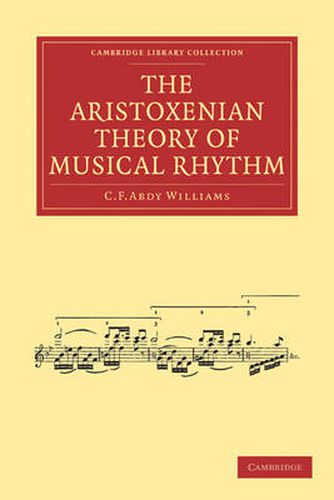Readings Newsletter
Become a Readings Member to make your shopping experience even easier.
Sign in or sign up for free!
You’re not far away from qualifying for FREE standard shipping within Australia
You’ve qualified for FREE standard shipping within Australia
The cart is loading…






‘Keeping time’, along with artistic accentuation and intelligent phrasing, is essential to successful musical performance. Rhythm alone had rarely been the subject of specialised study until the late nineteenth century, when several books on this topic by Rudolf Westphal were published in Leipzig. Westphal’s work inspired Charles Francis Abdy Williams’s 1911 book which is reissued here. Williams re-examines the classical and romantic repertoire from Handel to Tchaikovsky in the light of ancient Greek musical theory, focusing particularly on the earliest writings by Artistoxenus of Tarentum (fourth century BCE). In Williams’s view, the rhythmic forms used by the Greeks are universally intelligible, and appear in all ages and cultures, unlike melodies or scales, which vary hugely. He provides insights into the microstructure of works including Bach’s oratorios, Beethoven’s sonatas and Schubert’s songs, which will continue to intrigue musicians, classicists and mathematicians today.
$9.00 standard shipping within Australia
FREE standard shipping within Australia for orders over $100.00
Express & International shipping calculated at checkout
‘Keeping time’, along with artistic accentuation and intelligent phrasing, is essential to successful musical performance. Rhythm alone had rarely been the subject of specialised study until the late nineteenth century, when several books on this topic by Rudolf Westphal were published in Leipzig. Westphal’s work inspired Charles Francis Abdy Williams’s 1911 book which is reissued here. Williams re-examines the classical and romantic repertoire from Handel to Tchaikovsky in the light of ancient Greek musical theory, focusing particularly on the earliest writings by Artistoxenus of Tarentum (fourth century BCE). In Williams’s view, the rhythmic forms used by the Greeks are universally intelligible, and appear in all ages and cultures, unlike melodies or scales, which vary hugely. He provides insights into the microstructure of works including Bach’s oratorios, Beethoven’s sonatas and Schubert’s songs, which will continue to intrigue musicians, classicists and mathematicians today.